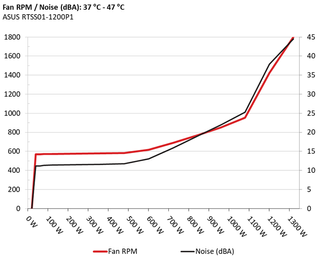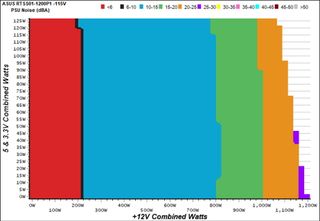Asus ROG Thor 1200W PSU Review: Asus Brings a Screen to the PSU Party
Why you can trust Tom's Hardware
Load Regulation, Hold-Up Time, Inrush Current, Efficiency and Noise
To learn more about our PSU tests and methodology, please check out How We Test Power Supply Units.
Primary Rails And 5VSB Load Regulation
The following charts show the main rails' voltage values recorded between a range of 40W up to the PSU's maximum specified load, along with the deviation (in percent). Tight regulation is an important consideration every time we review a power supply, because it facilitates constant voltage levels despite varying loads. Tight load regulation, among other things, improves the system’s stability, especially under overclocked conditions, and at the same time it applies less stress to the DC-DC converters that many system components utilize.








Load regulation is pretty tight on all rails but 5VSB. However, the Seasonic Prime Platinum 1200W (which is built on the same platform) achieves better performance.
Hold-Up Time
Put simply, hold-up time is the amount of time that the system can continue to run without shutting down or rebooting during a power interruption.







The hold-up time is much longer than 17ms and the power-ok signal is accurate.
Inrush Current
Inrush current, or switch-on surge, refers to the maximum instantaneous input current drawn by an electrical device when it is first turned on. A large-enough inrush current can cause circuit breakers and fuses to trip. It can also damage switches, relays, and bridge rectifiers. As a result, the lower the inrush current right as the PSU is turned on, the better.


The registered inrush currents are at normal levels, given the 1200W max power and the capacity of the bulk caps.
10-110% Load Tests
These tests reveal the unit’s load regulation and efficiency levels under high ambient temperatures. They also show how the fan speed profile behaves under tough operating conditions.
| Test # | 12V | 5V | 3.3V | 5VSB | DC/AC (Watts) | Efficiency | Fan Speed (RPM) | PSU Noise (dB[A]) | Temps (In/Out) | PF/AC Volts |
|---|---|---|---|---|---|---|---|---|---|---|
| 1 | 8.069A | 1.997A | 1.980A | 0.979A | 119.989 | 84.836% | 574 | 11.4 | 40.28°C | 0.983 |
| 12.195V | 5.005V | 3.330V | 5.106V | (*146) 141.436 | 46.61°C | 115.12V | ||||
| 2 | 17.127A | 3.000A | 2.971A | 1.178A | 239.688 | 89.464% | 577 | 11.5 | 40.89°C | 0.985 |
| 12.191V | 5.001V | 3.329V | 5.093V | (*268) 267.916 | 47.67°C | 115.11V | ||||
| 3 | 26.518A | 3.501A | 3.454A | 1.378A | 359.196 | 90.923% | 580 | 11.6 | 41.23°C | 0.990 |
| 12.188V | 4.998V | 3.328V | 5.081V | (*393) 395.053 | 48.93°C | 115.11V | ||||
| 4 | 35.982A | 4.003A | 3.967A | 1.579A | 479.632 | 91.352% | 584 | 11.8 | 41.86°C | 0.994 |
| 12.185V | 4.995V | 3.326V | 5.068V | (*525) 525.037 | 50.25°C | 115.11V | ||||
| 5 | 45.090A | 5.009A | 4.961A | 1.781A | 599.789 | 91.266% | 618 | 13.0 | 42.23°C | 0.996 |
| 12.182V | 4.992V | 3.325V | 5.054V | (*658) 657.191 | 51.83°C | 115.12V | ||||
| 6 | 54.203A | 6.014A | 5.957A | 1.984A | 719.939 | 90.921% | 687 | 15.8 | 42.71°C | 0.997 |
| 12.179V | 4.989V | 3.323V | 5.041V | (*792) 791.827 | 53.18°C | 115.12V | ||||
| 7 | 63.285A | 7.020A | 6.953A | 2.188A | 839.657 | 90.382% | 766 | 18.9 | 43.49°C | 0.997 |
| 12.176V | 4.986V | 3.322V | 5.027V | (*926) 929.006 | 54.64°C | 115.13V | ||||
| 8 | 72.436A | 8.030A | 7.950A | 2.394A | 960.163 | 89.669% | 851 | 22.0 | 43.76°C | 0.998 |
| 12.173V | 4.982V | 3.320V | 5.013V | (*1062) 1070.791 | 55.78°C | 115.13V | ||||
| 9 | 81.923A | 8.536A | 8.434A | 2.398A | 1079.498 | 88.924% | 953 | 25.3 | 44.94°C | 0.998 |
| 12.170V | 4.979V | 3.319V | 5.005V | (*1198) 1213.953 | 57.51°C | 115.13V | ||||
| 10 | 91.264A | 9.044A | 8.952A | 3.012A | 1199.945 | 88.028% | 1423 | 37.9 | 45.69°C | 0.998 |
| 12.165V | 4.977V | 3.318V | 4.981V | (*1340) 1363.136 | 59.24°C | 115.14V | ||||
| 11 | 101.168A | 9.048A | 8.952A | 3.017A | 1320.008 | 87.128% | 1799 | 44.5 | 46.74°C | 0.998 |
| 12.161V | 4.974V | 3.317V | 4.974V | (*1481) 1515.023 | 60.84°C | 115.14V | ||||
| CL1 | 0.149A | 15.001A | 14.999A | 0.000A | 126.603 | 82.327% | 769 | 18.9 | 42.80°C | 0.989 |
| 12.198V | 4.997V | 3.322V | 5.111V | (*157) 153.780 | 51.98°C | 115.13V | ||||
| CL2 | 100.020A | 1.002A | 0.997A | 1.000A | 1229.983 | 88.265% | 1476 | 39.3 | 45.23°C | 0.998 |
| 12.164V | 4.981V | 3.322V | 5.037V | (*1372) 1393.505 | 58.68°C | 115.14V |
*Readings acquired by the PSU’s OLED screen.
As you can see in the table above and more specifically in the DC/AC Watts column, the readings that the unit's OLED screen provide are highly accurate from test #2 to #6. In the rest of the tests the deviations are not that large. This is impressive, given that we compare the readings of a high-end (and expensive) power analyzer with the ones from a significantly lower-cost circuit provide. Calculating the AC Watts (aka power draw) is a much more complex process compared to the DC Watts calculation.
The fan profile is very relaxed, even under extra tough conditions like the ones that we apply during our tests. The PSU's output noise only exceeds 40 dB(A) during the overload test with 110% of its max-rated-capacity load at 47°C ambient.
Under high operating temperatures the PSU is not able to meet any of the three 80 PLUS Platinum requirements at 20%, 50% and full load scenarios. This probably won't be the case at the low temperatures (23°C +-5°C) typically applied during testing.
20-80W Load Tests
In the following tests, we measure the PSU's efficiency at loads significantly lower than 10 percent of its maximum capacity (the lowest load the 80 PLUS standard measures). This is important for representing when a PC is idle, with power-saving features turned on.
| Test # | 12V | 5V | 3.3V | 5VSB | DC/AC (Watts) | Efficiency | Fan Speed (RPM) | PSU Noise (dB[A]) | PF/AC Volts |
|---|---|---|---|---|---|---|---|---|---|
| 1 | 1.184A | 0.498A | 0.477A | 0.195A | 19.521 | 59.899% | 0 | <6.0 | 0.862 |
| 12.192V | 5.011V | 3.335V | 5.131V | (*34) 32.590 | 115.13V | ||||
| 2 | 2.432A | 0.999A | 0.987A | 0.390A | 39.938 | 72.958% | 570 | 11.2 | 0.937 |
| 12.191V | 5.007V | 3.332V | 5.125V | (*56) 54.741 | 115.12V | ||||
| 3 | 3.611A | 1.498A | 1.469A | 0.586A | 59.410 | 77.914% | 570 | 11.2 | 0.956 |
| 12.190V | 5.006V | 3.331V | 5.119V | (*76) 76.251 | 115.12V | ||||
| 4 | 4.854A | 1.998A | 1.979A | 0.782A | 79.786 | 81.647% | 572 | 11.3 | 0.975 |
| 12.195V | 5.005V | 3.331V | 5.113V | (*99) 97.721 | 115.12V |
*Readings acquired by the PSU’s OLED screen.
The OLED screen is spot on in test three, while in the rest of tests it's still close to the real readings.
We would like to see higher efficiency levels in these tests, especially with 20W load.
Efficiency
Next, we plotted a chart showing the unit’s efficiency at low loads and loads from 10 to 110 percent of its maximum-rated capacity. The higher a PSU’s efficiency, the less energy is wasted, leading to a reduced carbon footprint and lower electricity bills.




Compared to the original platform, the Asus offering is not as efficient. As expected, the additional circuits draw more power, so the efficiency difference with the Prime Platinum is notable, especially under light loads.
5VSB Efficiency
| Test # | 5VSB | DC/AC (Watts) | Efficiency | PF/AC Volts |
|---|---|---|---|---|
| 1 | 0.100A | 0.514 | 73.429% | 0.074 |
| 5.138V | 0.700 | 115.11V | ||
| 2 | 0.250A | 1.284 | 78.340% | 0.159 |
| 5.135V | 1.639 | 115.11V | ||
| 3 | 0.550A | 2.821 | 80.577% | 0.277 |
| 5.128V | 3.501 | 115.11V | ||
| 4 | 1.000A | 5.119 | 80.741% | 0.371 |
| 5.118V | 6.340 | 115.11V | ||
| 5 | 1.500A | 7.663 | 80.979% | 0.424 |
| 5.107V | 9.463 | 115.11V | ||
| 6 | 3.000A | 15.225 | 79.963% | 0.493 |
| 5.075V | 19.040 | 115.11V |


The 5VSB rail might not have very tight load regulation, but its efficiency levels are satisfactory.
Power Consumption In Idle And Standby
| Mode | 12V | 5V | 3.3V | 5VSB | Watts | PF/AC Volts |
|---|---|---|---|---|---|---|
| Idle | 12.178V | 5.018V | 3.340V | 5.143V | 13.805 | 0.631 |
| 115.1V | ||||||
| Standby | 0.057 | 0.006 | ||||
| 115.1V |


Fan RPM, Delta Temperature, And Output Noise
All results here are obtained between an ambient temperature of 37°C (98.6°F) to 47°C (116.6°F).


The fan's passive operation doesn't last long under high operating temperatures, but the fan profile is not aggressive.
The following results are obtained at 30°C (86°F) to 32°C (89.6°F) ambient temperature.


The passive operation lasts up to 200W load, with the PSU's fan profile being highly relaxed after that load level. More than 1000W of power output is necessary to make the fan spin at higher than 800 RPM.
MORE: Best Power Supplies
MORE: How We Test Power Supplies
MORE: All Power Supply Content
Current page: Load Regulation, Hold-Up Time, Inrush Current, Efficiency and Noise
Prev Page Specifications and Part Analysis Next Page Protection Features, DC Power Sequencing, Cross-Load Tests and Infrared ImagesStay on the Cutting Edge
Join the experts who read Tom's Hardware for the inside track on enthusiast PC tech news — and have for over 25 years. We'll send breaking news and in-depth reviews of CPUs, GPUs, AI, maker hardware and more straight to your inbox.
Aris Mpitziopoulos is a Contributing Editor at Tom's Hardware US, covering PSUs.


